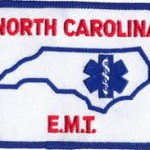Note: This entry was originally posted on a blog I created for my History of Medicine class final project during December 2012.
If you had to guess, what federal body would you think EMS falls under: the Department of Transportation, or the US Public Health Service? If you guessed the US Public Health Service, you'd be wrong. Read on to find out why. This story is crucial to understanding the evolution of EMS in the United States and the problems the system currently faces, problems that should concern every person who could ever need to call an ambulance.
The Nouveau plan de constitution pour la médecine en France published in the 1790's laid down new standards for medical education and practice in France, becoming a charter of sorts. It's true that educational models had existed long before this point, but the Nouveau plan illustrates that in medicine, a single document can serve to bring together many circulating ideas into one coherent system, thereby facilitating its implementation. In 1966, the National Academy of Sciences released its seminal paper, Accidental Death and Disability: The Neglected Disease of Modern Society -- known in the EMS trade as simply "The White Paper" -- which had the same effect of rallying EMS in the United States (you can download the paper here).
The modern EMS system in America owes its roots directly to this White Paper, and had it never been published, EMS might have evolved in a very different way. Particularly, to the modern audience, it makes sense that EMS -- emergency medical services -- might fall under the purview of some federal medical regulatory body, and yet it belongs to the Department of Transportation. Understanding the White Paper can explain this apparently awkward ordering. The White Paper, after all, was written largely in response to the growing problem of car wrecks, as motorized vehicles not only increased the incident of trauma in the US but also provided dramatic examples of just how bad trauma could be. Cars made trauma very visible.
The White Paper's preface stated, innocently enough, its purpose:
During the past three years, Committees on Trauma, Shock, and Anesthesia, and special task forces of the Division of Medical Sciences, National Academy of Sciences-National Research Council, have reviewed with representatives the present status of initial care and emergency medical services afforded to the victims of accidental injury. These studies include reviews of ambulance services, voice communication systems, emergency departments and intensive care units of hospitals; revision of the first aid textbook for the American National Red Cross; preparation of a formal statement on cardiopulmonary resuscitation; and participation in disaster survey studies.
However, what followed would be a scathing indictment of America's handling of traumatic injuries. The paper opened with these frightening statistics:
In 1965, 52 million injuries killed 107,000, temporarily disabled over 10 million and permanently impaired 400,000 American citizens at a cost of approximately $18 billion. This neglected epidemic of modern society is the nation's most important environmental health problem. It is the leading cause of death in the first half of life's span. Although 49,000 deaths in 1965 were due to motor-vehicle accidents...
The White Paper claimed that when it came to trauma, Americans had stuck their heads in the sand, when the cure was relatively simple. The same health measures that worked for other diseases -- the paper singled out the federal response to birth defects, muscular dystrophy, sclerosis, and palsy -- needed to be applied to trauma. For starters, communities needed to address a lack of proper training and equipment used in the response to accidental injuries (I've included only those points related to EMS):
- Millions lack instruction in basic first aid.
- Few are adequately trained in the advanced techniques of cardiopulmonary resuscitation, childbirth, or other lifesaving measures, yet every ambulance and rescue squad attendant, policeman, firefighter, paramedical worker and worker in high-risk industry should be trained.
- Local political authorities have neglected their responsibility to provide optimal emergency medical services.
- Potentials of the U. S. Public Health Service programs in accident prevention and emergency medical services have not been fully exploited.
- Data are lacking on which to determine the number of individuals whose lives are lost or injuries are compounded by misguided attempts at rescue or first aid, absence of physicians at the scene of the injury, unsuitable ambulances with inadequate equipment and untrained attendants, lack of traffic control, or the lack of voice communication facilities.
Immediately following these complaints, the paper suggested the formation of a "Conduct of National Conferences on Emergency Medical Services" that would expose the public to the shortcomings of the system and provide opportunities to correct those flaws. Community councils would formulate and teach first aid programs, disseminate information to the public, and mobilize allied health systems.
After these summarized findings, the White Paper went into more detail about the broad scope of the problem and offered more specific fixes. Under its "Emergency First Aid and Medical Care" section, the paper noted that the physician could rarely act at the scene of the accident, but rather his role was often relegated to the hospital. Therefore, it was stressed the need to educate people who could provide care in the absence of the doctor. The military would provide a model of a successful system.
One of the serious problems today in both the lay and the professional areas of responsibility for total care is the broad gap between knowledge and its application. Expert consultations returning from both Korea and Vietnam have publicly asserted that, if seriously wounded, their chances of survival would be better in the zone of combat than on the average city street. Excellence of initial first aid, efficiency of transportation, and energetic treatment of military casualties have proved to be major factors in the progressive decrease in death rates of battle casualties... Reduction of the time lag from receipt of injury to initiation of medical care is one of the important elements in prevention of death and permanent disability in the combat zone.
The White Paper recommended that starting with fifth grade, every American should receive basic first aid training; furthermore, any employee who was likely to encounter a traumatic injury -- such as an ambulance attendant -- should be required to have additional, more advanced training. However, the paper noted, such employees rarely had training in even the simplest care.
Next, it turned its sights to ambulance services. When it came to the items used on ambulances, it bemoaned "low [standards], frequent use of unnecessarily expensive and usually ill-designed equipment, generally inadequate supplies." As for the ambulances themselves, it was claimed that "no manufacturer produces...a vehicle that can be termed an ambulance... [They] are produced by conversion...expensive in outward appearance, but impractical for resuscitative care." The outlook for the attendants that manned the ambulance was equally as dismal, and the paper cited a lack of "generally accepted standards for the competence or training of ambulance attendance," claiming that "certification is a rarity." Few communities, it found, provided sufficient financial support for proper ambulance services, even though such services were as important as firefighting and police forces.
Also addressed were communications systems and emergency departments. With the proper communications facilities, the patient's condition could be known before the ambulance ever arrived on scene, ambulance attendants and hospital staff could converse on care, and traffic could be managed to allow access for emergency vehicles. "Although it is possible to converse with astronauts in outer space, communication is seldom possible between an ambulance and the emergency department that it is approaching," the paper wryly noted.
The human suffering and financial loss from preventable accidental death constitute a public health problem second only to the ravages of ancient plagues or world wars. In one year alone, vehicle accidents kill more than we lost in the Korean War, and in the past 60 years more Americans have died from accidents than from combat wounds in all of our wars.
I would like to close with the above quote from the White Paper, which I feel is an excellent example of its beautifully caustic writing that made no attempt to sugar the realities of the trauma problem. The White Paper simply couldn't be ignored. Therefore, it's not surprising that within three years, the federal government had taken notice and began to enact laws that would help the paper's suggestions become a reality.
The outcome
In response to the White Paper, Congress passed the National Traffic and Vehicle Safety Act of 1966. Although much of the act focused on new safety standards for vehicles (such as head rests and seat belts), an amendment added in 1970, Standard 11, included provisions for EMS. Furthermore, the act created what is now called the National Highway Traffic Safety Administration, a division of the Department of Transportation, which would become responsible for setting basic EMS curricula standards. These standards were soon published, but it was left to the states to adopt and legislate EMT educational requirements as they saw fit.
The act "encouraged ambulance legislation and standards, EMS personnel standards, pilot programs in rural areas, communications system improvements, trauma registries, rehabilitation studies, and mass casualty care." Specifically, Standard 11 promoted "comprehensive state and local EMS systems guided by the Accidental Death and Disability paper, the American College of Surgeons, Armed Forces techniques, and experience from selected states" (for example, the White Paper had upheld Baltimore as representative of a well-run civilian EMS). Although the original EMT educational requirements were quite different than from what they are today, the way for professionalism in EMS had been paved.
Today
Although the act was essential in modernizing EMS, its focus on vehicular accidents led to the field being relegated to the command of highway specialists. To compound that matter, federal funding problems caused EMS to be rolled up with the DOT, and inertia keeps it there today. Regardless, the White Paper led to numerous improvements. Yet, at the same time, many of the initial concerns raised in the White Paper remain problems in 2012. I'll explore this more in my explanatory essay.







